Influence of Organization's Culture, Power and Politics on Performance of Employees
VerifiedAdded on 2023/01/12
|15
|4453
|64
AI Summary
This report discusses the influence of organization's culture, power, and politics on the performance of employees. It also highlights different motivational theories and models to increase employee performance.
Contribute Materials
Your contribution can guide someone’s learning journey. Share your
documents today.

ORGANIZATIONAL
BEHAVIOUR
BEHAVIOUR
Secure Best Marks with AI Grader
Need help grading? Try our AI Grader for instant feedback on your assignments.
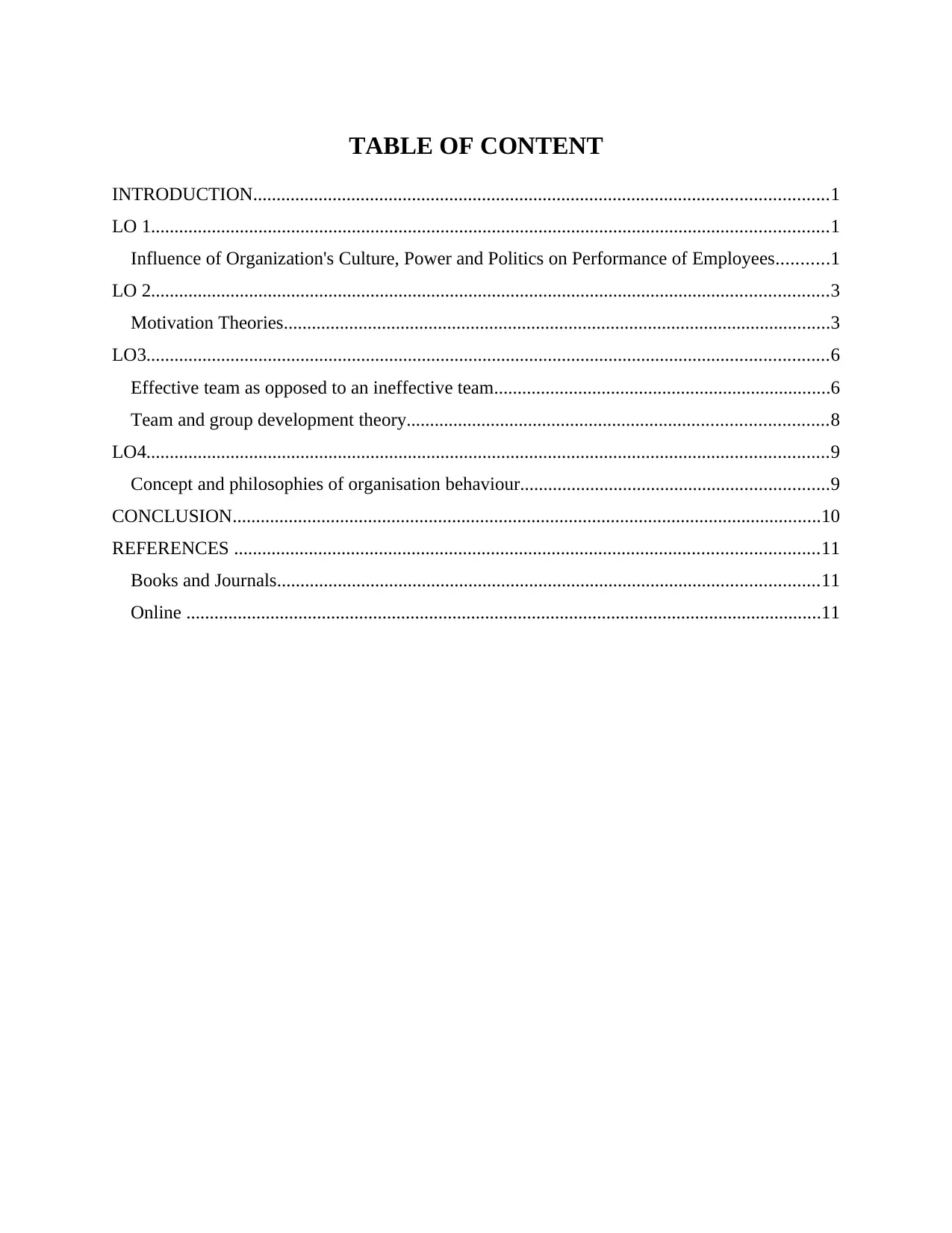
TABLE OF CONTENT
INTRODUCTION...........................................................................................................................1
LO 1.................................................................................................................................................1
Influence of Organization's Culture, Power and Politics on Performance of Employees...........1
LO 2.................................................................................................................................................3
Motivation Theories.....................................................................................................................3
LO3..................................................................................................................................................6
Effective team as opposed to an ineffective team........................................................................6
Team and group development theory..........................................................................................8
LO4..................................................................................................................................................9
Concept and philosophies of organisation behaviour..................................................................9
CONCLUSION..............................................................................................................................10
REFERENCES .............................................................................................................................11
Books and Journals....................................................................................................................11
Online ........................................................................................................................................11
INTRODUCTION...........................................................................................................................1
LO 1.................................................................................................................................................1
Influence of Organization's Culture, Power and Politics on Performance of Employees...........1
LO 2.................................................................................................................................................3
Motivation Theories.....................................................................................................................3
LO3..................................................................................................................................................6
Effective team as opposed to an ineffective team........................................................................6
Team and group development theory..........................................................................................8
LO4..................................................................................................................................................9
Concept and philosophies of organisation behaviour..................................................................9
CONCLUSION..............................................................................................................................10
REFERENCES .............................................................................................................................11
Books and Journals....................................................................................................................11
Online ........................................................................................................................................11
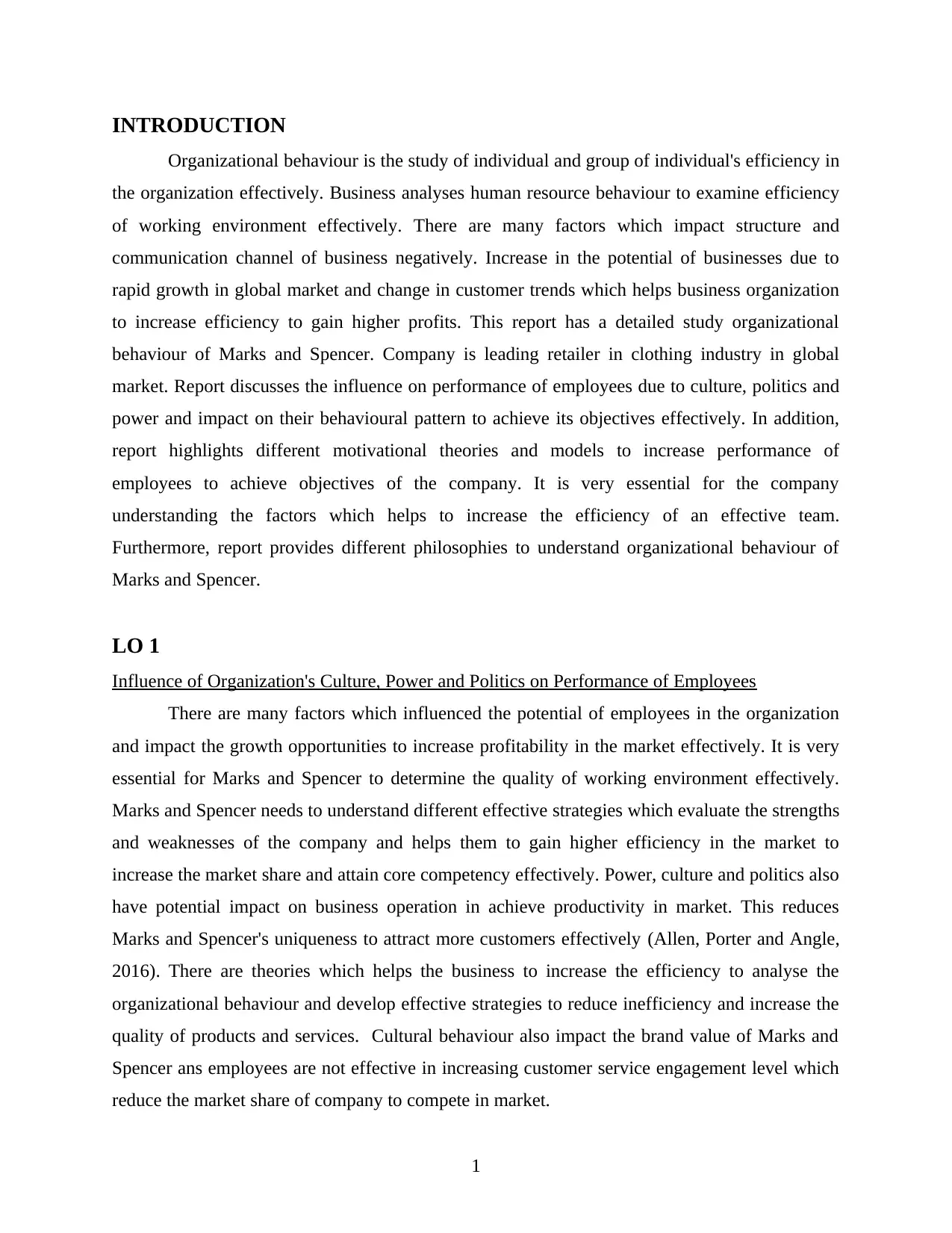
INTRODUCTION
Organizational behaviour is the study of individual and group of individual's efficiency in
the organization effectively. Business analyses human resource behaviour to examine efficiency
of working environment effectively. There are many factors which impact structure and
communication channel of business negatively. Increase in the potential of businesses due to
rapid growth in global market and change in customer trends which helps business organization
to increase efficiency to gain higher profits. This report has a detailed study organizational
behaviour of Marks and Spencer. Company is leading retailer in clothing industry in global
market. Report discusses the influence on performance of employees due to culture, politics and
power and impact on their behavioural pattern to achieve its objectives effectively. In addition,
report highlights different motivational theories and models to increase performance of
employees to achieve objectives of the company. It is very essential for the company
understanding the factors which helps to increase the efficiency of an effective team.
Furthermore, report provides different philosophies to understand organizational behaviour of
Marks and Spencer.
LO 1
Influence of Organization's Culture, Power and Politics on Performance of Employees
There are many factors which influenced the potential of employees in the organization
and impact the growth opportunities to increase profitability in the market effectively. It is very
essential for Marks and Spencer to determine the quality of working environment effectively.
Marks and Spencer needs to understand different effective strategies which evaluate the strengths
and weaknesses of the company and helps them to gain higher efficiency in the market to
increase the market share and attain core competency effectively. Power, culture and politics also
have potential impact on business operation in achieve productivity in market. This reduces
Marks and Spencer's uniqueness to attract more customers effectively (Allen, Porter and Angle,
2016). There are theories which helps the business to increase the efficiency to analyse the
organizational behaviour and develop effective strategies to reduce inefficiency and increase the
quality of products and services. Cultural behaviour also impact the brand value of Marks and
Spencer ans employees are not effective in increasing customer service engagement level which
reduce the market share of company to compete in market.
1
Organizational behaviour is the study of individual and group of individual's efficiency in
the organization effectively. Business analyses human resource behaviour to examine efficiency
of working environment effectively. There are many factors which impact structure and
communication channel of business negatively. Increase in the potential of businesses due to
rapid growth in global market and change in customer trends which helps business organization
to increase efficiency to gain higher profits. This report has a detailed study organizational
behaviour of Marks and Spencer. Company is leading retailer in clothing industry in global
market. Report discusses the influence on performance of employees due to culture, politics and
power and impact on their behavioural pattern to achieve its objectives effectively. In addition,
report highlights different motivational theories and models to increase performance of
employees to achieve objectives of the company. It is very essential for the company
understanding the factors which helps to increase the efficiency of an effective team.
Furthermore, report provides different philosophies to understand organizational behaviour of
Marks and Spencer.
LO 1
Influence of Organization's Culture, Power and Politics on Performance of Employees
There are many factors which influenced the potential of employees in the organization
and impact the growth opportunities to increase profitability in the market effectively. It is very
essential for Marks and Spencer to determine the quality of working environment effectively.
Marks and Spencer needs to understand different effective strategies which evaluate the strengths
and weaknesses of the company and helps them to gain higher efficiency in the market to
increase the market share and attain core competency effectively. Power, culture and politics also
have potential impact on business operation in achieve productivity in market. This reduces
Marks and Spencer's uniqueness to attract more customers effectively (Allen, Porter and Angle,
2016). There are theories which helps the business to increase the efficiency to analyse the
organizational behaviour and develop effective strategies to reduce inefficiency and increase the
quality of products and services. Cultural behaviour also impact the brand value of Marks and
Spencer ans employees are not effective in increasing customer service engagement level which
reduce the market share of company to compete in market.
1
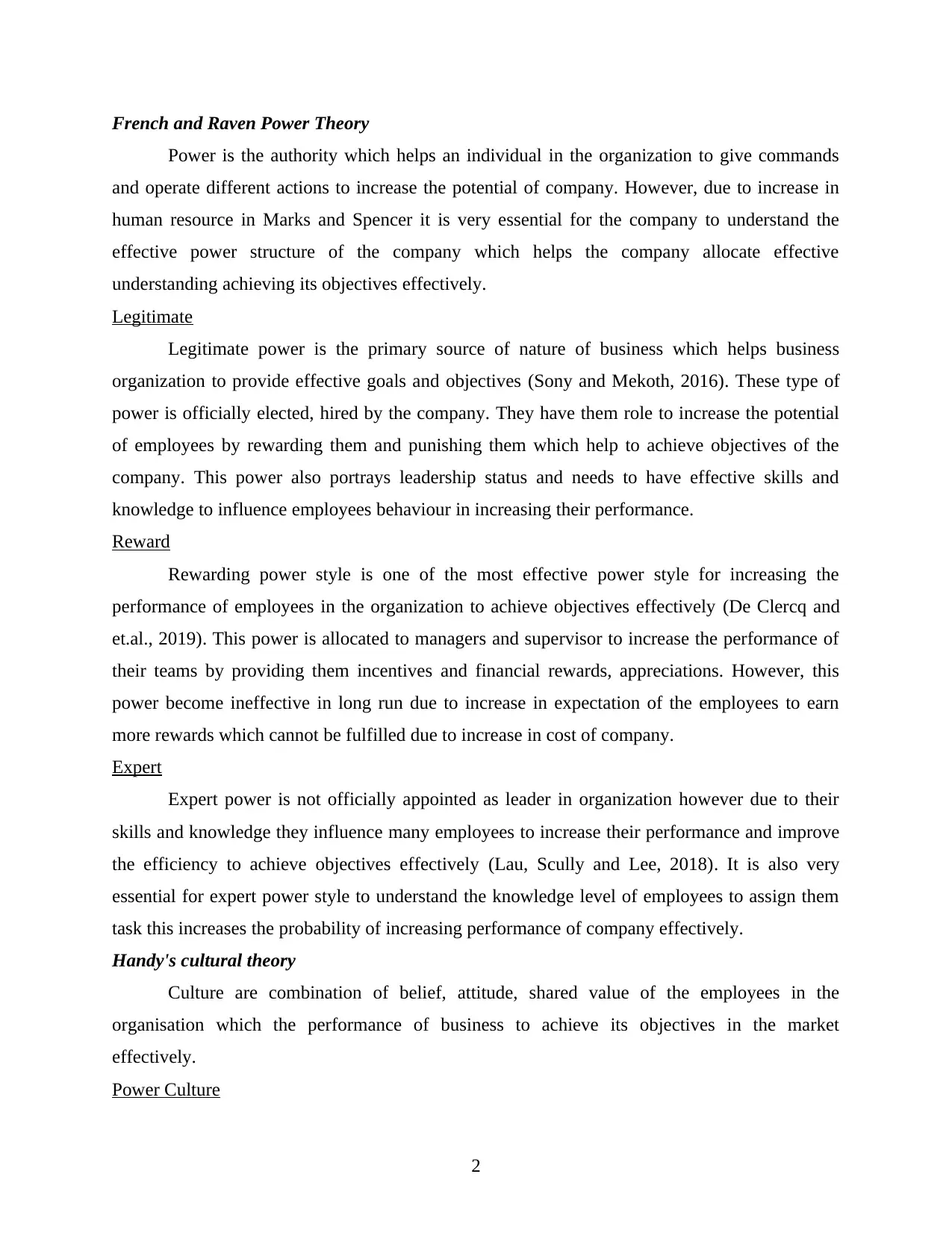
French and Raven Power Theory
Power is the authority which helps an individual in the organization to give commands
and operate different actions to increase the potential of company. However, due to increase in
human resource in Marks and Spencer it is very essential for the company to understand the
effective power structure of the company which helps the company allocate effective
understanding achieving its objectives effectively.
Legitimate
Legitimate power is the primary source of nature of business which helps business
organization to provide effective goals and objectives (Sony and Mekoth, 2016). These type of
power is officially elected, hired by the company. They have them role to increase the potential
of employees by rewarding them and punishing them which help to achieve objectives of the
company. This power also portrays leadership status and needs to have effective skills and
knowledge to influence employees behaviour in increasing their performance.
Reward
Rewarding power style is one of the most effective power style for increasing the
performance of employees in the organization to achieve objectives effectively (De Clercq and
et.al., 2019). This power is allocated to managers and supervisor to increase the performance of
their teams by providing them incentives and financial rewards, appreciations. However, this
power become ineffective in long run due to increase in expectation of the employees to earn
more rewards which cannot be fulfilled due to increase in cost of company.
Expert
Expert power is not officially appointed as leader in organization however due to their
skills and knowledge they influence many employees to increase their performance and improve
the efficiency to achieve objectives effectively (Lau, Scully and Lee, 2018). It is also very
essential for expert power style to understand the knowledge level of employees to assign them
task this increases the probability of increasing performance of company effectively.
Handy's cultural theory
Culture are combination of belief, attitude, shared value of the employees in the
organisation which the performance of business to achieve its objectives in the market
effectively.
Power Culture
2
Power is the authority which helps an individual in the organization to give commands
and operate different actions to increase the potential of company. However, due to increase in
human resource in Marks and Spencer it is very essential for the company to understand the
effective power structure of the company which helps the company allocate effective
understanding achieving its objectives effectively.
Legitimate
Legitimate power is the primary source of nature of business which helps business
organization to provide effective goals and objectives (Sony and Mekoth, 2016). These type of
power is officially elected, hired by the company. They have them role to increase the potential
of employees by rewarding them and punishing them which help to achieve objectives of the
company. This power also portrays leadership status and needs to have effective skills and
knowledge to influence employees behaviour in increasing their performance.
Reward
Rewarding power style is one of the most effective power style for increasing the
performance of employees in the organization to achieve objectives effectively (De Clercq and
et.al., 2019). This power is allocated to managers and supervisor to increase the performance of
their teams by providing them incentives and financial rewards, appreciations. However, this
power become ineffective in long run due to increase in expectation of the employees to earn
more rewards which cannot be fulfilled due to increase in cost of company.
Expert
Expert power is not officially appointed as leader in organization however due to their
skills and knowledge they influence many employees to increase their performance and improve
the efficiency to achieve objectives effectively (Lau, Scully and Lee, 2018). It is also very
essential for expert power style to understand the knowledge level of employees to assign them
task this increases the probability of increasing performance of company effectively.
Handy's cultural theory
Culture are combination of belief, attitude, shared value of the employees in the
organisation which the performance of business to achieve its objectives in the market
effectively.
Power Culture
2
Secure Best Marks with AI Grader
Need help grading? Try our AI Grader for instant feedback on your assignments.
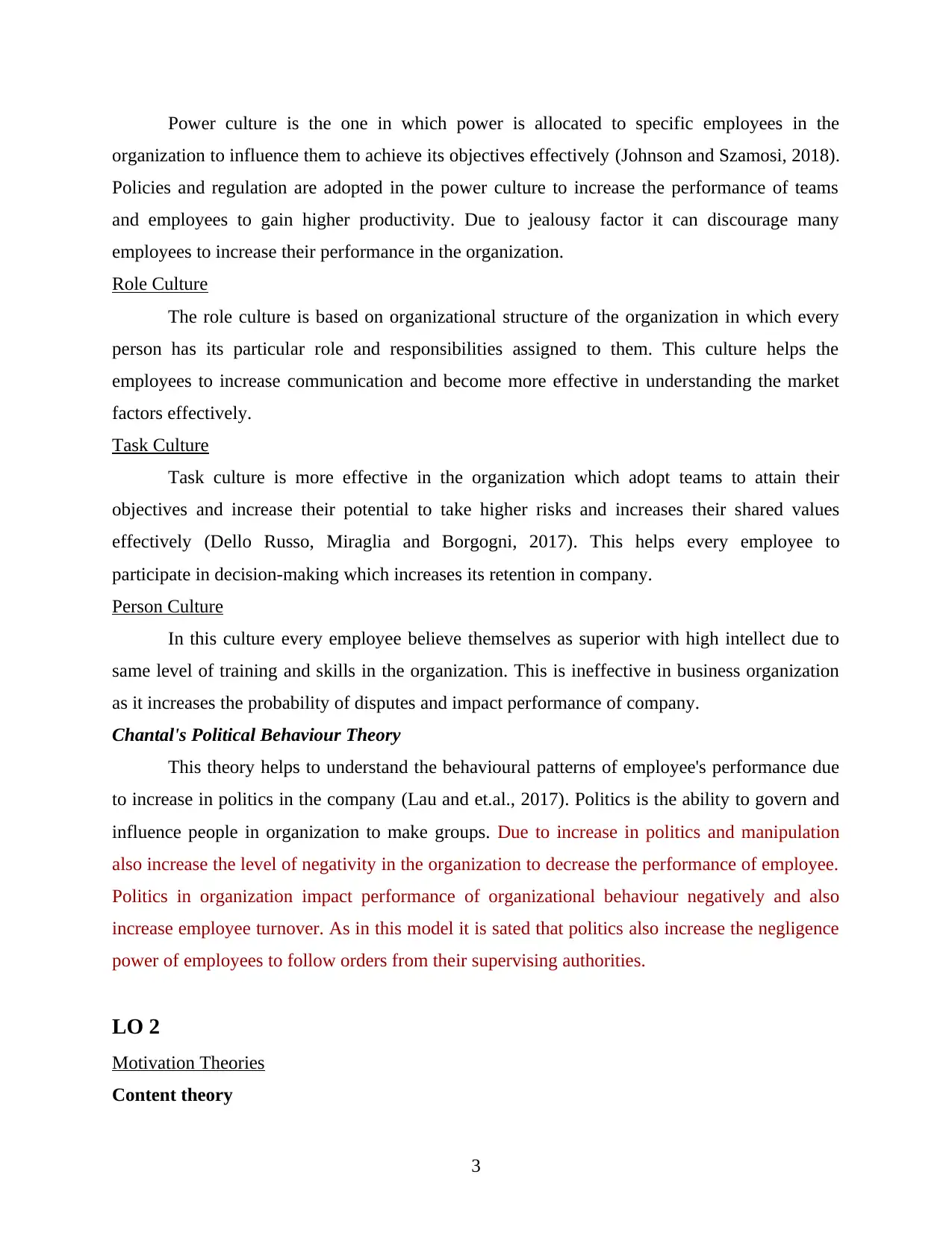
Power culture is the one in which power is allocated to specific employees in the
organization to influence them to achieve its objectives effectively (Johnson and Szamosi, 2018).
Policies and regulation are adopted in the power culture to increase the performance of teams
and employees to gain higher productivity. Due to jealousy factor it can discourage many
employees to increase their performance in the organization.
Role Culture
The role culture is based on organizational structure of the organization in which every
person has its particular role and responsibilities assigned to them. This culture helps the
employees to increase communication and become more effective in understanding the market
factors effectively.
Task Culture
Task culture is more effective in the organization which adopt teams to attain their
objectives and increase their potential to take higher risks and increases their shared values
effectively (Dello Russo, Miraglia and Borgogni, 2017). This helps every employee to
participate in decision-making which increases its retention in company.
Person Culture
In this culture every employee believe themselves as superior with high intellect due to
same level of training and skills in the organization. This is ineffective in business organization
as it increases the probability of disputes and impact performance of company.
Chantal's Political Behaviour Theory
This theory helps to understand the behavioural patterns of employee's performance due
to increase in politics in the company (Lau and et.al., 2017). Politics is the ability to govern and
influence people in organization to make groups. Due to increase in politics and manipulation
also increase the level of negativity in the organization to decrease the performance of employee.
Politics in organization impact performance of organizational behaviour negatively and also
increase employee turnover. As in this model it is sated that politics also increase the negligence
power of employees to follow orders from their supervising authorities.
LO 2
Motivation Theories
Content theory
3
organization to influence them to achieve its objectives effectively (Johnson and Szamosi, 2018).
Policies and regulation are adopted in the power culture to increase the performance of teams
and employees to gain higher productivity. Due to jealousy factor it can discourage many
employees to increase their performance in the organization.
Role Culture
The role culture is based on organizational structure of the organization in which every
person has its particular role and responsibilities assigned to them. This culture helps the
employees to increase communication and become more effective in understanding the market
factors effectively.
Task Culture
Task culture is more effective in the organization which adopt teams to attain their
objectives and increase their potential to take higher risks and increases their shared values
effectively (Dello Russo, Miraglia and Borgogni, 2017). This helps every employee to
participate in decision-making which increases its retention in company.
Person Culture
In this culture every employee believe themselves as superior with high intellect due to
same level of training and skills in the organization. This is ineffective in business organization
as it increases the probability of disputes and impact performance of company.
Chantal's Political Behaviour Theory
This theory helps to understand the behavioural patterns of employee's performance due
to increase in politics in the company (Lau and et.al., 2017). Politics is the ability to govern and
influence people in organization to make groups. Due to increase in politics and manipulation
also increase the level of negativity in the organization to decrease the performance of employee.
Politics in organization impact performance of organizational behaviour negatively and also
increase employee turnover. As in this model it is sated that politics also increase the negligence
power of employees to follow orders from their supervising authorities.
LO 2
Motivation Theories
Content theory
3
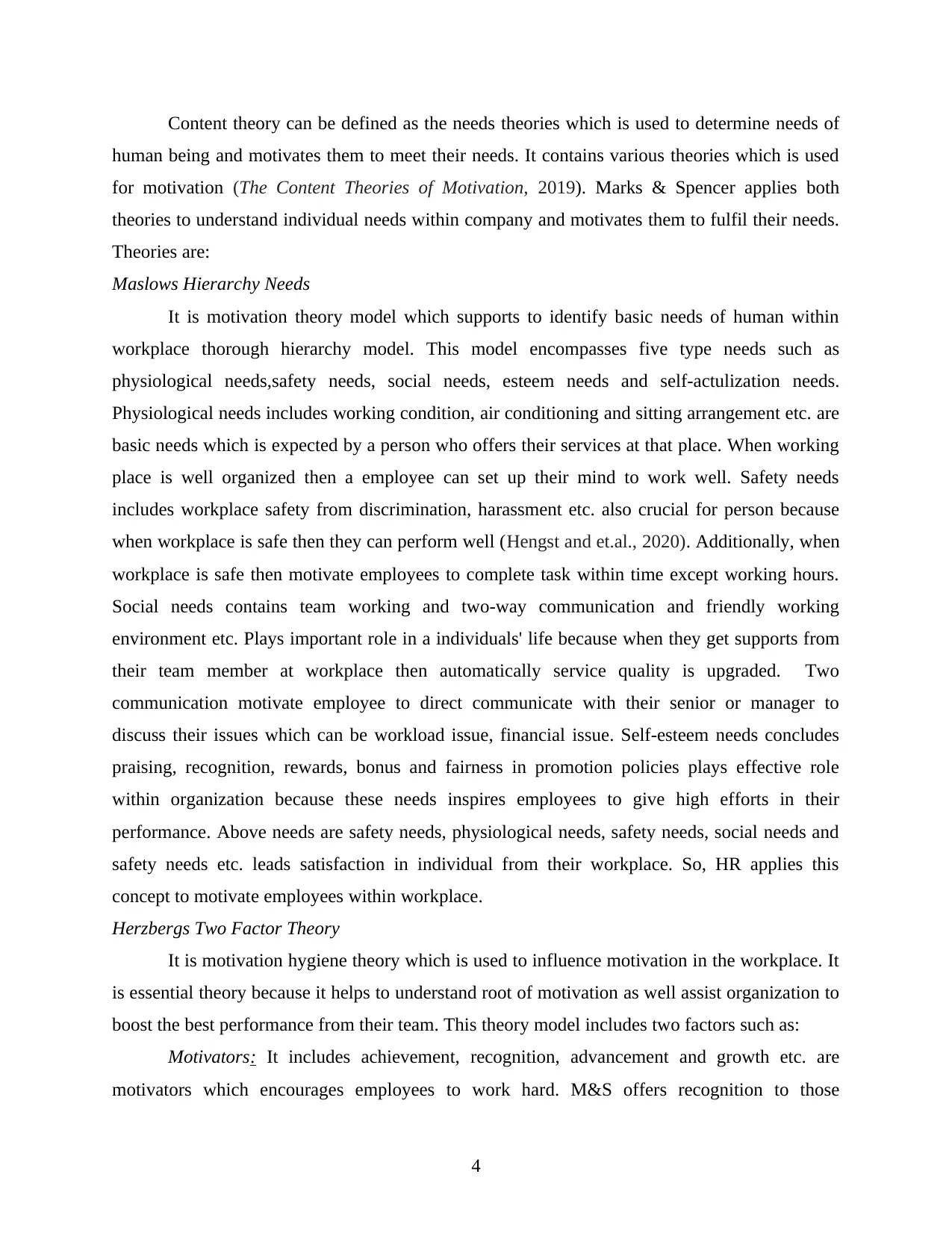
Content theory can be defined as the needs theories which is used to determine needs of
human being and motivates them to meet their needs. It contains various theories which is used
for motivation (The Content Theories of Motivation, 2019). Marks & Spencer applies both
theories to understand individual needs within company and motivates them to fulfil their needs.
Theories are:
Maslows Hierarchy Needs
It is motivation theory model which supports to identify basic needs of human within
workplace thorough hierarchy model. This model encompasses five type needs such as
physiological needs,safety needs, social needs, esteem needs and self-actulization needs.
Physiological needs includes working condition, air conditioning and sitting arrangement etc. are
basic needs which is expected by a person who offers their services at that place. When working
place is well organized then a employee can set up their mind to work well. Safety needs
includes workplace safety from discrimination, harassment etc. also crucial for person because
when workplace is safe then they can perform well (Hengst and et.al., 2020). Additionally, when
workplace is safe then motivate employees to complete task within time except working hours.
Social needs contains team working and two-way communication and friendly working
environment etc. Plays important role in a individuals' life because when they get supports from
their team member at workplace then automatically service quality is upgraded. Two
communication motivate employee to direct communicate with their senior or manager to
discuss their issues which can be workload issue, financial issue. Self-esteem needs concludes
praising, recognition, rewards, bonus and fairness in promotion policies plays effective role
within organization because these needs inspires employees to give high efforts in their
performance. Above needs are safety needs, physiological needs, safety needs, social needs and
safety needs etc. leads satisfaction in individual from their workplace. So, HR applies this
concept to motivate employees within workplace.
Herzbergs Two Factor Theory
It is motivation hygiene theory which is used to influence motivation in the workplace. It
is essential theory because it helps to understand root of motivation as well assist organization to
boost the best performance from their team. This theory model includes two factors such as:
Motivators: It includes achievement, recognition, advancement and growth etc. are
motivators which encourages employees to work hard. M&S offers recognition to those
4
human being and motivates them to meet their needs. It contains various theories which is used
for motivation (The Content Theories of Motivation, 2019). Marks & Spencer applies both
theories to understand individual needs within company and motivates them to fulfil their needs.
Theories are:
Maslows Hierarchy Needs
It is motivation theory model which supports to identify basic needs of human within
workplace thorough hierarchy model. This model encompasses five type needs such as
physiological needs,safety needs, social needs, esteem needs and self-actulization needs.
Physiological needs includes working condition, air conditioning and sitting arrangement etc. are
basic needs which is expected by a person who offers their services at that place. When working
place is well organized then a employee can set up their mind to work well. Safety needs
includes workplace safety from discrimination, harassment etc. also crucial for person because
when workplace is safe then they can perform well (Hengst and et.al., 2020). Additionally, when
workplace is safe then motivate employees to complete task within time except working hours.
Social needs contains team working and two-way communication and friendly working
environment etc. Plays important role in a individuals' life because when they get supports from
their team member at workplace then automatically service quality is upgraded. Two
communication motivate employee to direct communicate with their senior or manager to
discuss their issues which can be workload issue, financial issue. Self-esteem needs concludes
praising, recognition, rewards, bonus and fairness in promotion policies plays effective role
within organization because these needs inspires employees to give high efforts in their
performance. Above needs are safety needs, physiological needs, safety needs, social needs and
safety needs etc. leads satisfaction in individual from their workplace. So, HR applies this
concept to motivate employees within workplace.
Herzbergs Two Factor Theory
It is motivation hygiene theory which is used to influence motivation in the workplace. It
is essential theory because it helps to understand root of motivation as well assist organization to
boost the best performance from their team. This theory model includes two factors such as:
Motivators: It includes achievement, recognition, advancement and growth etc. are
motivators which encourages employees to work hard. M&S offers recognition to those
4
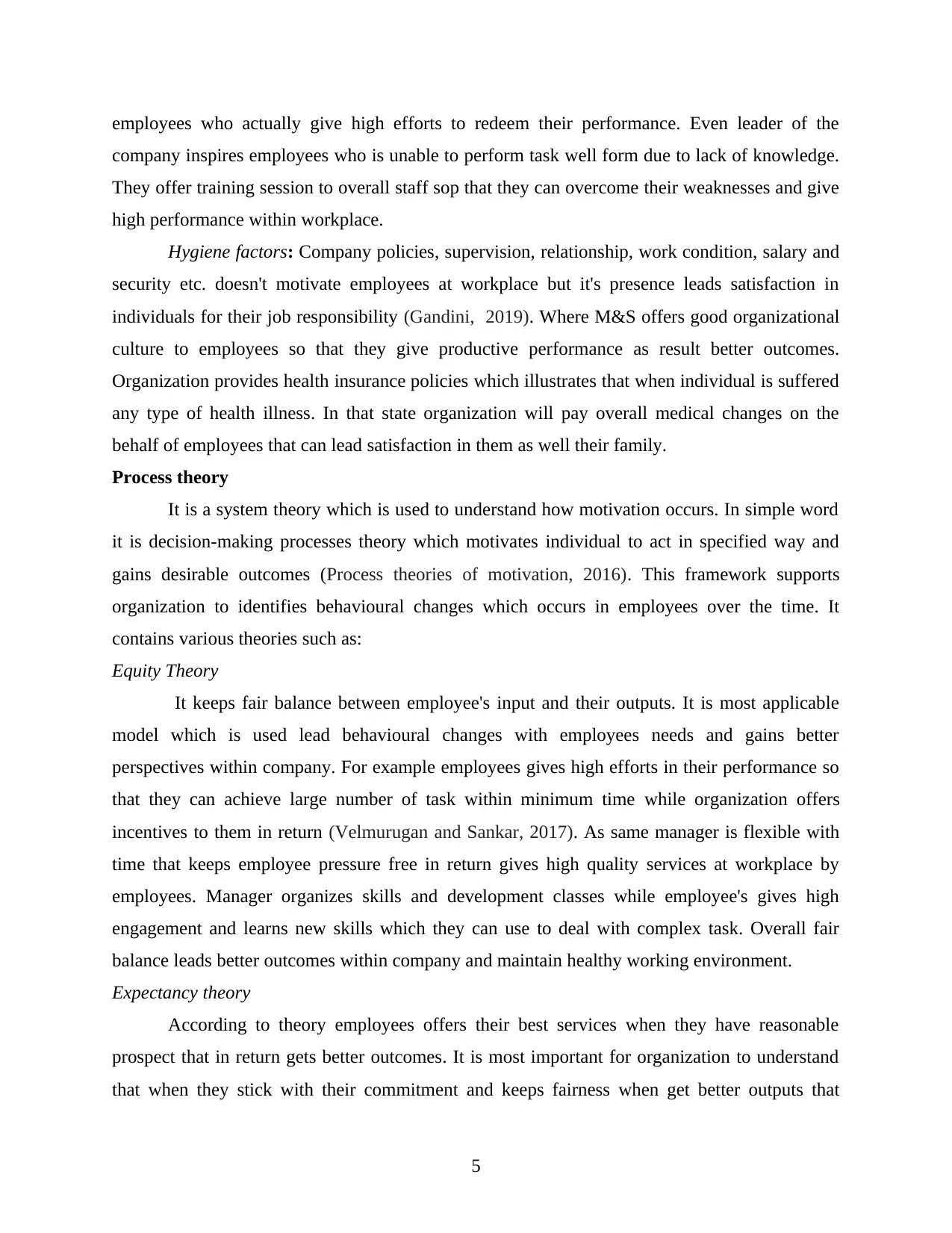
employees who actually give high efforts to redeem their performance. Even leader of the
company inspires employees who is unable to perform task well form due to lack of knowledge.
They offer training session to overall staff sop that they can overcome their weaknesses and give
high performance within workplace.
Hygiene factors: Company policies, supervision, relationship, work condition, salary and
security etc. doesn't motivate employees at workplace but it's presence leads satisfaction in
individuals for their job responsibility (Gandini, 2019). Where M&S offers good organizational
culture to employees so that they give productive performance as result better outcomes.
Organization provides health insurance policies which illustrates that when individual is suffered
any type of health illness. In that state organization will pay overall medical changes on the
behalf of employees that can lead satisfaction in them as well their family.
Process theory
It is a system theory which is used to understand how motivation occurs. In simple word
it is decision-making processes theory which motivates individual to act in specified way and
gains desirable outcomes (Process theories of motivation, 2016). This framework supports
organization to identifies behavioural changes which occurs in employees over the time. It
contains various theories such as:
Equity Theory
It keeps fair balance between employee's input and their outputs. It is most applicable
model which is used lead behavioural changes with employees needs and gains better
perspectives within company. For example employees gives high efforts in their performance so
that they can achieve large number of task within minimum time while organization offers
incentives to them in return (Velmurugan and Sankar, 2017). As same manager is flexible with
time that keeps employee pressure free in return gives high quality services at workplace by
employees. Manager organizes skills and development classes while employee's gives high
engagement and learns new skills which they can use to deal with complex task. Overall fair
balance leads better outcomes within company and maintain healthy working environment.
Expectancy theory
According to theory employees offers their best services when they have reasonable
prospect that in return gets better outcomes. It is most important for organization to understand
that when they stick with their commitment and keeps fairness when get better outputs that
5
company inspires employees who is unable to perform task well form due to lack of knowledge.
They offer training session to overall staff sop that they can overcome their weaknesses and give
high performance within workplace.
Hygiene factors: Company policies, supervision, relationship, work condition, salary and
security etc. doesn't motivate employees at workplace but it's presence leads satisfaction in
individuals for their job responsibility (Gandini, 2019). Where M&S offers good organizational
culture to employees so that they give productive performance as result better outcomes.
Organization provides health insurance policies which illustrates that when individual is suffered
any type of health illness. In that state organization will pay overall medical changes on the
behalf of employees that can lead satisfaction in them as well their family.
Process theory
It is a system theory which is used to understand how motivation occurs. In simple word
it is decision-making processes theory which motivates individual to act in specified way and
gains desirable outcomes (Process theories of motivation, 2016). This framework supports
organization to identifies behavioural changes which occurs in employees over the time. It
contains various theories such as:
Equity Theory
It keeps fair balance between employee's input and their outputs. It is most applicable
model which is used lead behavioural changes with employees needs and gains better
perspectives within company. For example employees gives high efforts in their performance so
that they can achieve large number of task within minimum time while organization offers
incentives to them in return (Velmurugan and Sankar, 2017). As same manager is flexible with
time that keeps employee pressure free in return gives high quality services at workplace by
employees. Manager organizes skills and development classes while employee's gives high
engagement and learns new skills which they can use to deal with complex task. Overall fair
balance leads better outcomes within company and maintain healthy working environment.
Expectancy theory
According to theory employees offers their best services when they have reasonable
prospect that in return gets better outcomes. It is most important for organization to understand
that when they stick with their commitment and keeps fairness when get better outputs that
5
Paraphrase This Document
Need a fresh take? Get an instant paraphrase of this document with our AI Paraphraser
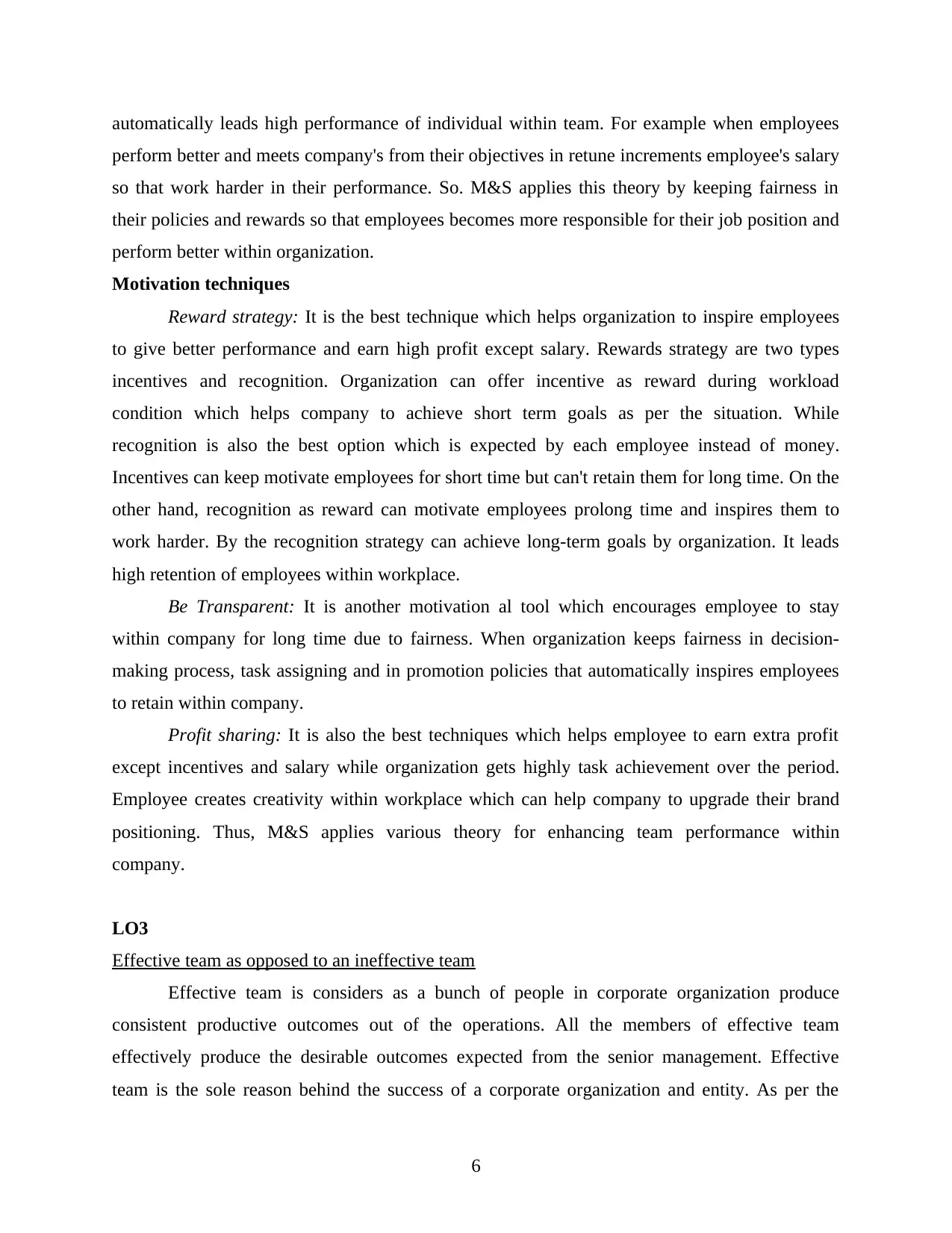
automatically leads high performance of individual within team. For example when employees
perform better and meets company's from their objectives in retune increments employee's salary
so that work harder in their performance. So. M&S applies this theory by keeping fairness in
their policies and rewards so that employees becomes more responsible for their job position and
perform better within organization.
Motivation techniques
Reward strategy: It is the best technique which helps organization to inspire employees
to give better performance and earn high profit except salary. Rewards strategy are two types
incentives and recognition. Organization can offer incentive as reward during workload
condition which helps company to achieve short term goals as per the situation. While
recognition is also the best option which is expected by each employee instead of money.
Incentives can keep motivate employees for short time but can't retain them for long time. On the
other hand, recognition as reward can motivate employees prolong time and inspires them to
work harder. By the recognition strategy can achieve long-term goals by organization. It leads
high retention of employees within workplace.
Be Transparent: It is another motivation al tool which encourages employee to stay
within company for long time due to fairness. When organization keeps fairness in decision-
making process, task assigning and in promotion policies that automatically inspires employees
to retain within company.
Profit sharing: It is also the best techniques which helps employee to earn extra profit
except incentives and salary while organization gets highly task achievement over the period.
Employee creates creativity within workplace which can help company to upgrade their brand
positioning. Thus, M&S applies various theory for enhancing team performance within
company.
LO3
Effective team as opposed to an ineffective team
Effective team is considers as a bunch of people in corporate organization produce
consistent productive outcomes out of the operations. All the members of effective team
effectively produce the desirable outcomes expected from the senior management. Effective
team is the sole reason behind the success of a corporate organization and entity. As per the
6
perform better and meets company's from their objectives in retune increments employee's salary
so that work harder in their performance. So. M&S applies this theory by keeping fairness in
their policies and rewards so that employees becomes more responsible for their job position and
perform better within organization.
Motivation techniques
Reward strategy: It is the best technique which helps organization to inspire employees
to give better performance and earn high profit except salary. Rewards strategy are two types
incentives and recognition. Organization can offer incentive as reward during workload
condition which helps company to achieve short term goals as per the situation. While
recognition is also the best option which is expected by each employee instead of money.
Incentives can keep motivate employees for short time but can't retain them for long time. On the
other hand, recognition as reward can motivate employees prolong time and inspires them to
work harder. By the recognition strategy can achieve long-term goals by organization. It leads
high retention of employees within workplace.
Be Transparent: It is another motivation al tool which encourages employee to stay
within company for long time due to fairness. When organization keeps fairness in decision-
making process, task assigning and in promotion policies that automatically inspires employees
to retain within company.
Profit sharing: It is also the best techniques which helps employee to earn extra profit
except incentives and salary while organization gets highly task achievement over the period.
Employee creates creativity within workplace which can help company to upgrade their brand
positioning. Thus, M&S applies various theory for enhancing team performance within
company.
LO3
Effective team as opposed to an ineffective team
Effective team is considers as a bunch of people in corporate organization produce
consistent productive outcomes out of the operations. All the members of effective team
effectively produce the desirable outcomes expected from the senior management. Effective
team is the sole reason behind the success of a corporate organization and entity. As per the
6
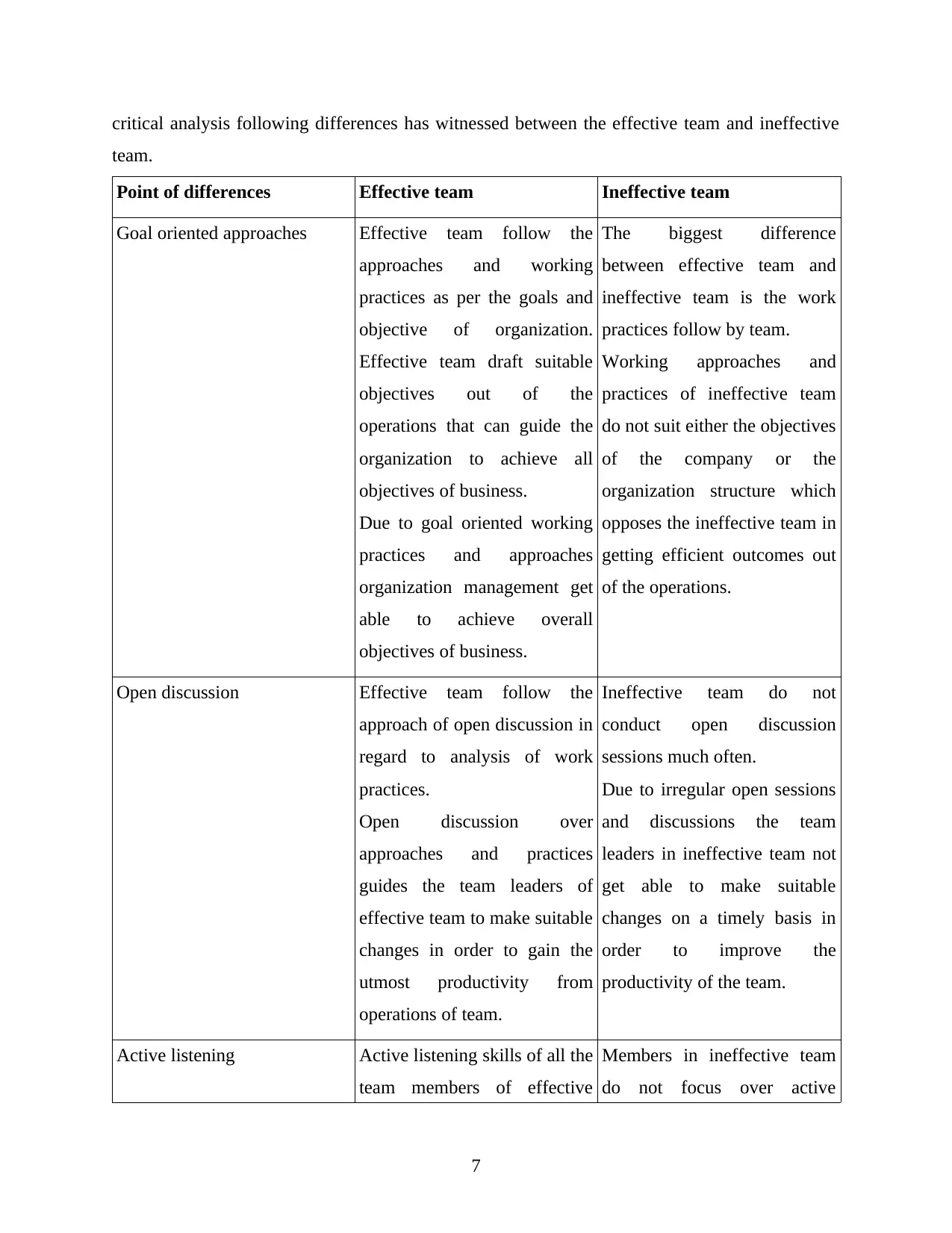
critical analysis following differences has witnessed between the effective team and ineffective
team.
Point of differences Effective team Ineffective team
Goal oriented approaches Effective team follow the
approaches and working
practices as per the goals and
objective of organization.
Effective team draft suitable
objectives out of the
operations that can guide the
organization to achieve all
objectives of business.
Due to goal oriented working
practices and approaches
organization management get
able to achieve overall
objectives of business.
The biggest difference
between effective team and
ineffective team is the work
practices follow by team.
Working approaches and
practices of ineffective team
do not suit either the objectives
of the company or the
organization structure which
opposes the ineffective team in
getting efficient outcomes out
of the operations.
Open discussion Effective team follow the
approach of open discussion in
regard to analysis of work
practices.
Open discussion over
approaches and practices
guides the team leaders of
effective team to make suitable
changes in order to gain the
utmost productivity from
operations of team.
Ineffective team do not
conduct open discussion
sessions much often.
Due to irregular open sessions
and discussions the team
leaders in ineffective team not
get able to make suitable
changes on a timely basis in
order to improve the
productivity of the team.
Active listening Active listening skills of all the
team members of effective
Members in ineffective team
do not focus over active
7
team.
Point of differences Effective team Ineffective team
Goal oriented approaches Effective team follow the
approaches and working
practices as per the goals and
objective of organization.
Effective team draft suitable
objectives out of the
operations that can guide the
organization to achieve all
objectives of business.
Due to goal oriented working
practices and approaches
organization management get
able to achieve overall
objectives of business.
The biggest difference
between effective team and
ineffective team is the work
practices follow by team.
Working approaches and
practices of ineffective team
do not suit either the objectives
of the company or the
organization structure which
opposes the ineffective team in
getting efficient outcomes out
of the operations.
Open discussion Effective team follow the
approach of open discussion in
regard to analysis of work
practices.
Open discussion over
approaches and practices
guides the team leaders of
effective team to make suitable
changes in order to gain the
utmost productivity from
operations of team.
Ineffective team do not
conduct open discussion
sessions much often.
Due to irregular open sessions
and discussions the team
leaders in ineffective team not
get able to make suitable
changes on a timely basis in
order to improve the
productivity of the team.
Active listening Active listening skills of all the
team members of effective
Members in ineffective team
do not focus over active
7

team is also a crucial factor
that make a team effective.
All the team members in
effective team always listen to
the guidance given by senior
authorities which make them
able to cope up with all the
operational challenges
(Corbets, Willy and Bischoff,
2017).
listening in conducting the
operations.
Due to inactive listening skills
members of ineffective team
not make efficient changes in
the practices they follow
which also restrict the
productivity of all team
members in ineffective team.
Decision-making Decision-making is among the
prime difference between the
effective team and ineffective
team.
Team leaders and members of
effective team make precise
decisions based on the
suitability of organization
structure and objective sof
company and based on the
critical analysis they make
suitable decisions which
support them to achieve the
highest level of efficiency.
Team remains ineffective due
to inappropriate decision-
making skills.
Team and group development theory
Management of Marks and Spencer follow the Tuck man model of team development.
Company management follow the above practices in order to build an effective team.
Forming: Forming is the initial stage of team development theory. After the team is formed all
team members meet and understand the characteristics and behaviour of other team members.
8
that make a team effective.
All the team members in
effective team always listen to
the guidance given by senior
authorities which make them
able to cope up with all the
operational challenges
(Corbets, Willy and Bischoff,
2017).
listening in conducting the
operations.
Due to inactive listening skills
members of ineffective team
not make efficient changes in
the practices they follow
which also restrict the
productivity of all team
members in ineffective team.
Decision-making Decision-making is among the
prime difference between the
effective team and ineffective
team.
Team leaders and members of
effective team make precise
decisions based on the
suitability of organization
structure and objective sof
company and based on the
critical analysis they make
suitable decisions which
support them to achieve the
highest level of efficiency.
Team remains ineffective due
to inappropriate decision-
making skills.
Team and group development theory
Management of Marks and Spencer follow the Tuck man model of team development.
Company management follow the above practices in order to build an effective team.
Forming: Forming is the initial stage of team development theory. After the team is formed all
team members meet and understand the characteristics and behaviour of other team members.
8
Secure Best Marks with AI Grader
Need help grading? Try our AI Grader for instant feedback on your assignments.
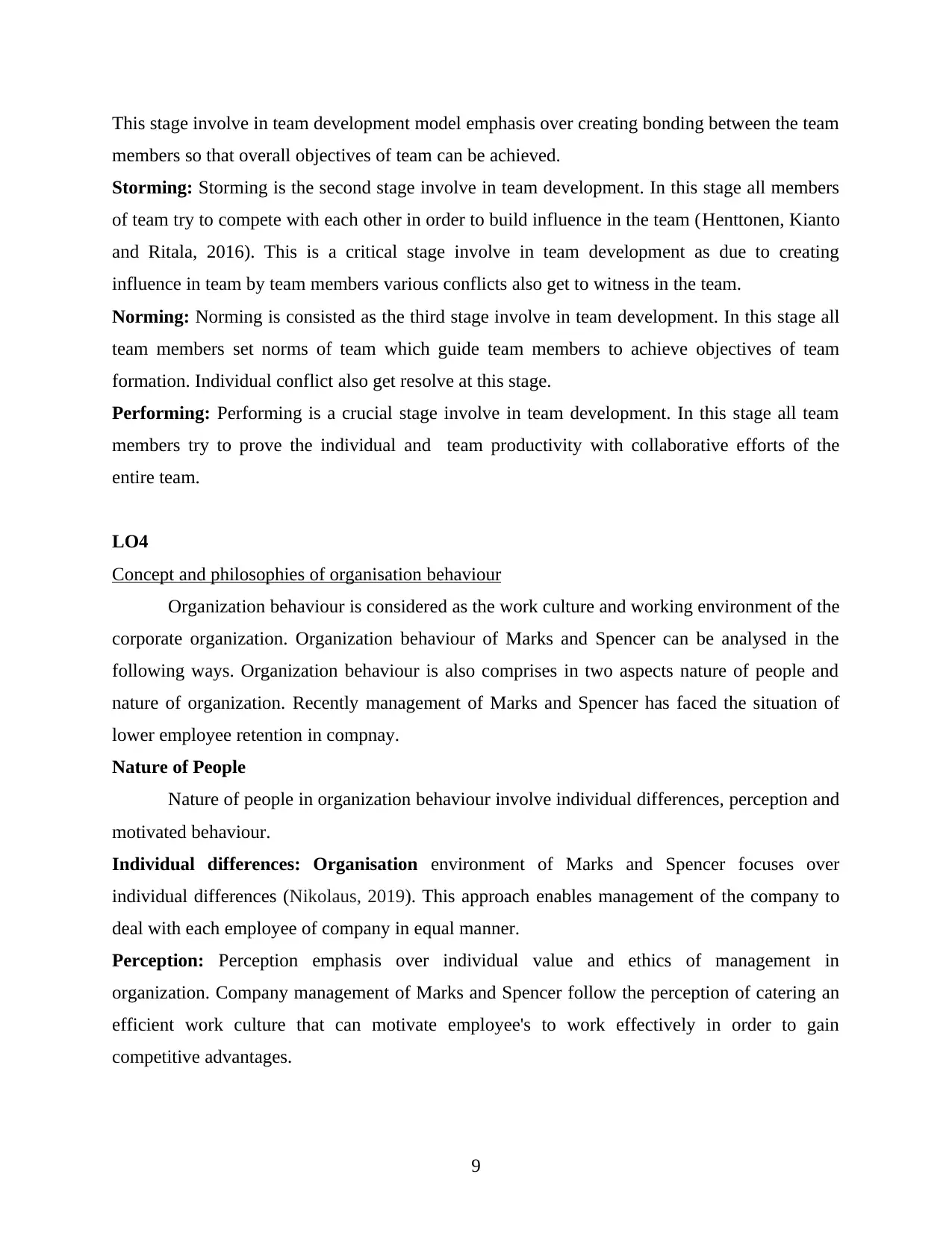
This stage involve in team development model emphasis over creating bonding between the team
members so that overall objectives of team can be achieved.
Storming: Storming is the second stage involve in team development. In this stage all members
of team try to compete with each other in order to build influence in the team (Henttonen, Kianto
and Ritala, 2016). This is a critical stage involve in team development as due to creating
influence in team by team members various conflicts also get to witness in the team.
Norming: Norming is consisted as the third stage involve in team development. In this stage all
team members set norms of team which guide team members to achieve objectives of team
formation. Individual conflict also get resolve at this stage.
Performing: Performing is a crucial stage involve in team development. In this stage all team
members try to prove the individual and team productivity with collaborative efforts of the
entire team.
LO4
Concept and philosophies of organisation behaviour
Organization behaviour is considered as the work culture and working environment of the
corporate organization. Organization behaviour of Marks and Spencer can be analysed in the
following ways. Organization behaviour is also comprises in two aspects nature of people and
nature of organization. Recently management of Marks and Spencer has faced the situation of
lower employee retention in compnay.
Nature of People
Nature of people in organization behaviour involve individual differences, perception and
motivated behaviour.
Individual differences: Organisation environment of Marks and Spencer focuses over
individual differences (Nikolaus, 2019). This approach enables management of the company to
deal with each employee of company in equal manner.
Perception: Perception emphasis over individual value and ethics of management in
organization. Company management of Marks and Spencer follow the perception of catering an
efficient work culture that can motivate employee's to work effectively in order to gain
competitive advantages.
9
members so that overall objectives of team can be achieved.
Storming: Storming is the second stage involve in team development. In this stage all members
of team try to compete with each other in order to build influence in the team (Henttonen, Kianto
and Ritala, 2016). This is a critical stage involve in team development as due to creating
influence in team by team members various conflicts also get to witness in the team.
Norming: Norming is consisted as the third stage involve in team development. In this stage all
team members set norms of team which guide team members to achieve objectives of team
formation. Individual conflict also get resolve at this stage.
Performing: Performing is a crucial stage involve in team development. In this stage all team
members try to prove the individual and team productivity with collaborative efforts of the
entire team.
LO4
Concept and philosophies of organisation behaviour
Organization behaviour is considered as the work culture and working environment of the
corporate organization. Organization behaviour of Marks and Spencer can be analysed in the
following ways. Organization behaviour is also comprises in two aspects nature of people and
nature of organization. Recently management of Marks and Spencer has faced the situation of
lower employee retention in compnay.
Nature of People
Nature of people in organization behaviour involve individual differences, perception and
motivated behaviour.
Individual differences: Organisation environment of Marks and Spencer focuses over
individual differences (Nikolaus, 2019). This approach enables management of the company to
deal with each employee of company in equal manner.
Perception: Perception emphasis over individual value and ethics of management in
organization. Company management of Marks and Spencer follow the perception of catering an
efficient work culture that can motivate employee's to work effectively in order to gain
competitive advantages.
9
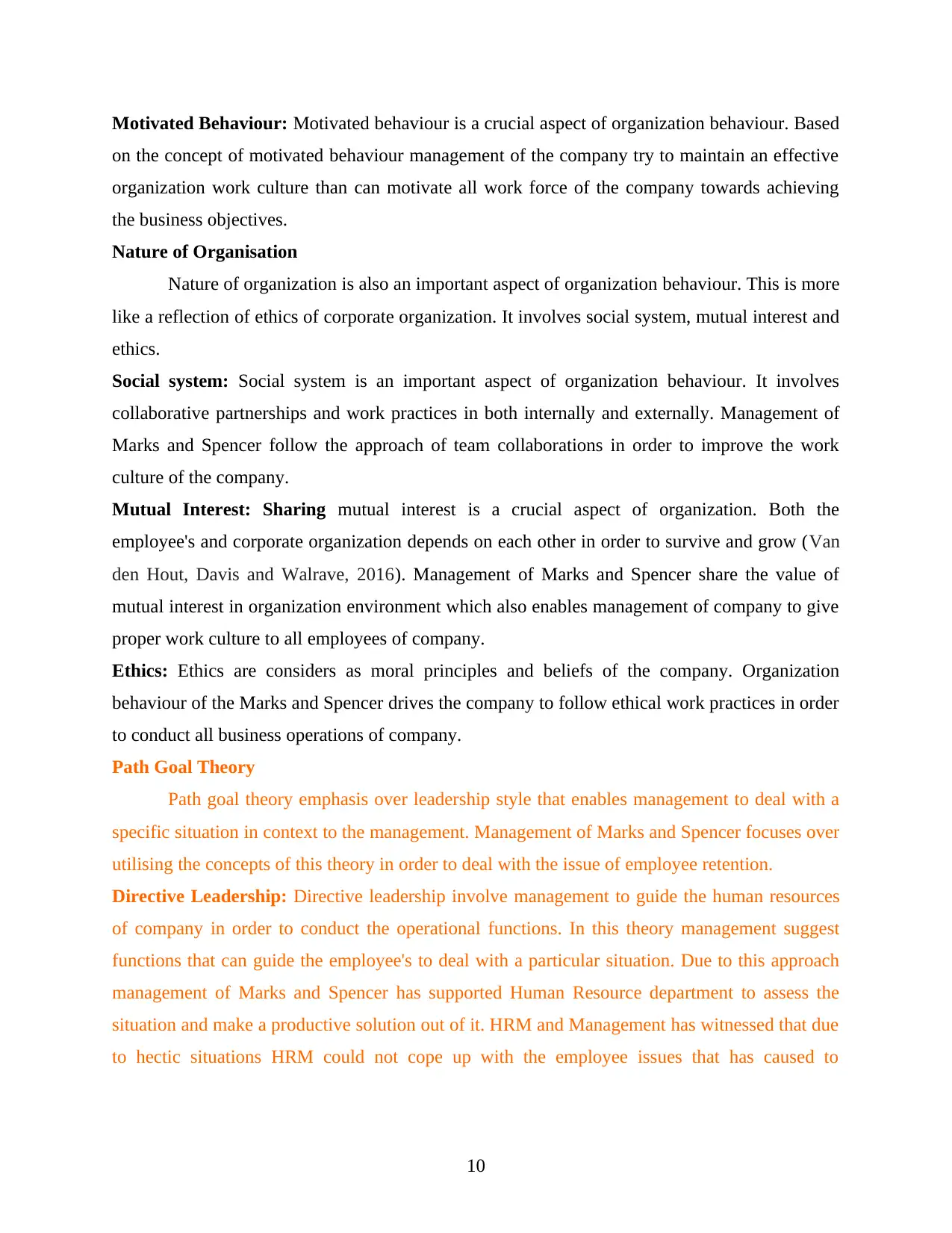
Motivated Behaviour: Motivated behaviour is a crucial aspect of organization behaviour. Based
on the concept of motivated behaviour management of the company try to maintain an effective
organization work culture than can motivate all work force of the company towards achieving
the business objectives.
Nature of Organisation
Nature of organization is also an important aspect of organization behaviour. This is more
like a reflection of ethics of corporate organization. It involves social system, mutual interest and
ethics.
Social system: Social system is an important aspect of organization behaviour. It involves
collaborative partnerships and work practices in both internally and externally. Management of
Marks and Spencer follow the approach of team collaborations in order to improve the work
culture of the company.
Mutual Interest: Sharing mutual interest is a crucial aspect of organization. Both the
employee's and corporate organization depends on each other in order to survive and grow (Van
den Hout, Davis and Walrave, 2016). Management of Marks and Spencer share the value of
mutual interest in organization environment which also enables management of company to give
proper work culture to all employees of company.
Ethics: Ethics are considers as moral principles and beliefs of the company. Organization
behaviour of the Marks and Spencer drives the company to follow ethical work practices in order
to conduct all business operations of company.
Path Goal Theory
Path goal theory emphasis over leadership style that enables management to deal with a
specific situation in context to the management. Management of Marks and Spencer focuses over
utilising the concepts of this theory in order to deal with the issue of employee retention.
Directive Leadership: Directive leadership involve management to guide the human resources
of company in order to conduct the operational functions. In this theory management suggest
functions that can guide the employee's to deal with a particular situation. Due to this approach
management of Marks and Spencer has supported Human Resource department to assess the
situation and make a productive solution out of it. HRM and Management has witnessed that due
to hectic situations HRM could not cope up with the employee issues that has caused to
10
on the concept of motivated behaviour management of the company try to maintain an effective
organization work culture than can motivate all work force of the company towards achieving
the business objectives.
Nature of Organisation
Nature of organization is also an important aspect of organization behaviour. This is more
like a reflection of ethics of corporate organization. It involves social system, mutual interest and
ethics.
Social system: Social system is an important aspect of organization behaviour. It involves
collaborative partnerships and work practices in both internally and externally. Management of
Marks and Spencer follow the approach of team collaborations in order to improve the work
culture of the company.
Mutual Interest: Sharing mutual interest is a crucial aspect of organization. Both the
employee's and corporate organization depends on each other in order to survive and grow (Van
den Hout, Davis and Walrave, 2016). Management of Marks and Spencer share the value of
mutual interest in organization environment which also enables management of company to give
proper work culture to all employees of company.
Ethics: Ethics are considers as moral principles and beliefs of the company. Organization
behaviour of the Marks and Spencer drives the company to follow ethical work practices in order
to conduct all business operations of company.
Path Goal Theory
Path goal theory emphasis over leadership style that enables management to deal with a
specific situation in context to the management. Management of Marks and Spencer focuses over
utilising the concepts of this theory in order to deal with the issue of employee retention.
Directive Leadership: Directive leadership involve management to guide the human resources
of company in order to conduct the operational functions. In this theory management suggest
functions that can guide the employee's to deal with a particular situation. Due to this approach
management of Marks and Spencer has supported Human Resource department to assess the
situation and make a productive solution out of it. HRM and Management has witnessed that due
to hectic situations HRM could not cope up with the employee issues that has caused to
10

employee's leaving the organisation. Management and HRM initiated to create employee
grievance centre in the organisation to deal with the situation.
Supportive Leadership: Supportive leadership is also an effective approach used in
organisation. Due to this approach management of company supported the HRM to deal with the
issue of low employee retention in company. Management supported the HRM to create an
employee grievance centre to deal with the situation effectively.
Participative Leadership: This is also a crucial leadership approach use in Marks and Spencer
by company management. Management participate in each situation in order to deal with the
situation. Management of the company participate in all activities like training and development
and other operations that supports employee's of company to deliver effective operations.
Management also applied this theory in dealing with the situation of low employee retention in
company.
Achievement leadership: This is also an effective leadership style company use. Due to this
approach management set goals for employee's. Management also supported the HRM to deal
with low employee retention in company. Management gave confidence to HRM in order to deal
with the situation effectively. Establishing employee grievance centre can be considered as the
proper solution to the issues. Management of company has honoured the HRM as well under this
approach for solving the issue.
All the factors comprises with organization behaviour of Marks and Spencer.
CONCLUSION
This report concludes that it is very essential for business organization to adopt different
strategies to evaluate the behaviour for employees to examine their performance in aching
objectives of the organization. Report discussed the importance of organizational behaviour
theories in business organization context with examples effectively. Report provided a brief
information about different motivational theories including Maslow's' motivation theories which
helps to increase performance of employees effectively. With the help of Belbin and Tuckman's
team development theories business also gain effective strategies to increase high performance
teams.
11
grievance centre in the organisation to deal with the situation.
Supportive Leadership: Supportive leadership is also an effective approach used in
organisation. Due to this approach management of company supported the HRM to deal with the
issue of low employee retention in company. Management supported the HRM to create an
employee grievance centre to deal with the situation effectively.
Participative Leadership: This is also a crucial leadership approach use in Marks and Spencer
by company management. Management participate in each situation in order to deal with the
situation. Management of the company participate in all activities like training and development
and other operations that supports employee's of company to deliver effective operations.
Management also applied this theory in dealing with the situation of low employee retention in
company.
Achievement leadership: This is also an effective leadership style company use. Due to this
approach management set goals for employee's. Management also supported the HRM to deal
with low employee retention in company. Management gave confidence to HRM in order to deal
with the situation effectively. Establishing employee grievance centre can be considered as the
proper solution to the issues. Management of company has honoured the HRM as well under this
approach for solving the issue.
All the factors comprises with organization behaviour of Marks and Spencer.
CONCLUSION
This report concludes that it is very essential for business organization to adopt different
strategies to evaluate the behaviour for employees to examine their performance in aching
objectives of the organization. Report discussed the importance of organizational behaviour
theories in business organization context with examples effectively. Report provided a brief
information about different motivational theories including Maslow's' motivation theories which
helps to increase performance of employees effectively. With the help of Belbin and Tuckman's
team development theories business also gain effective strategies to increase high performance
teams.
11
Paraphrase This Document
Need a fresh take? Get an instant paraphrase of this document with our AI Paraphraser
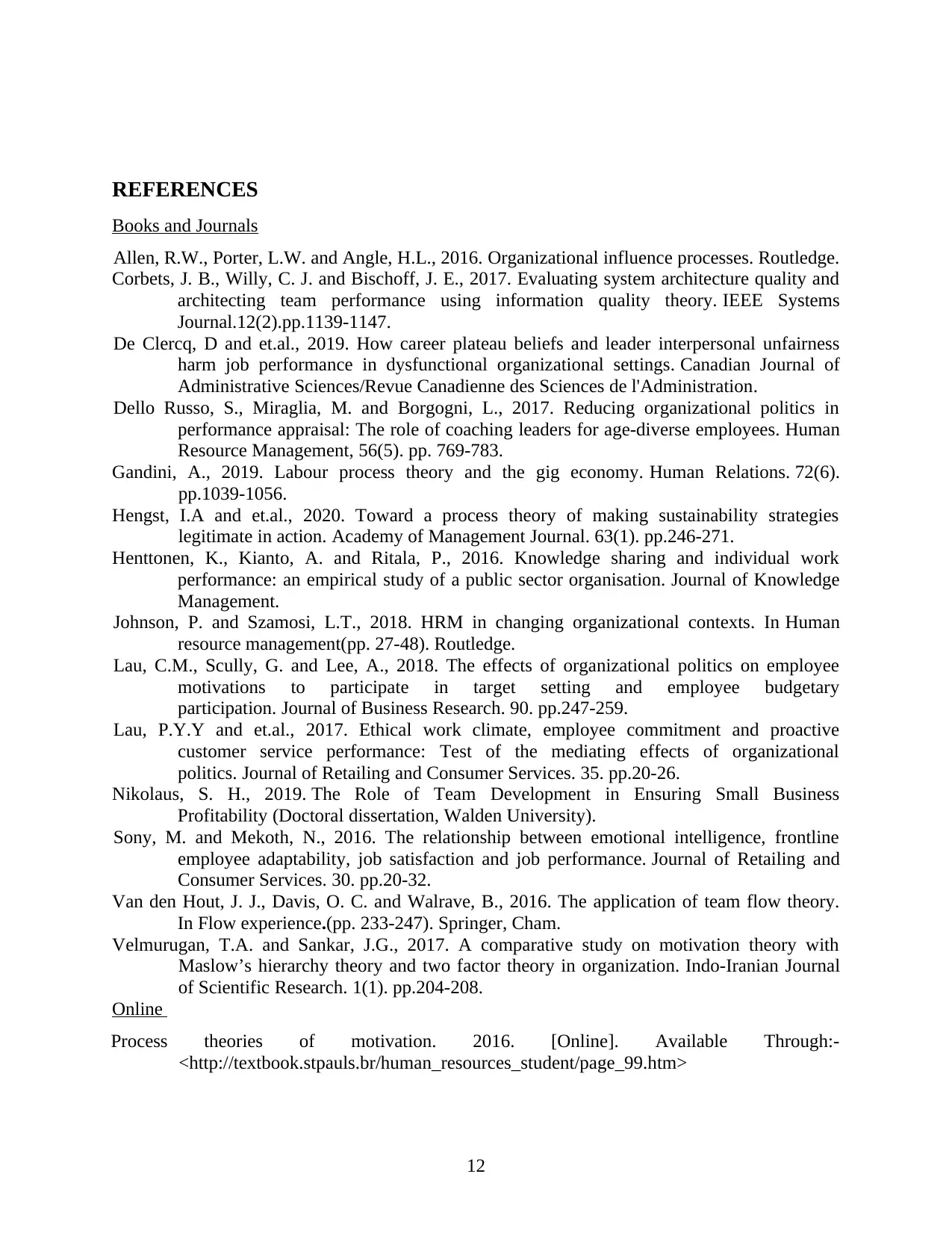
REFERENCES
Books and Journals
Allen, R.W., Porter, L.W. and Angle, H.L., 2016. Organizational influence processes. Routledge.
Corbets, J. B., Willy, C. J. and Bischoff, J. E., 2017. Evaluating system architecture quality and
architecting team performance using information quality theory. IEEE Systems
Journal.12(2).pp.1139-1147.
De Clercq, D and et.al., 2019. How career plateau beliefs and leader interpersonal unfairness
harm job performance in dysfunctional organizational settings. Canadian Journal of
Administrative Sciences/Revue Canadienne des Sciences de l'Administration.
Dello Russo, S., Miraglia, M. and Borgogni, L., 2017. Reducing organizational politics in
performance appraisal: The role of coaching leaders for age‐diverse employees. Human
Resource Management, 56(5). pp. 769-783.
Gandini, A., 2019. Labour process theory and the gig economy. Human Relations. 72(6).
pp.1039-1056.
Hengst, I.A and et.al., 2020. Toward a process theory of making sustainability strategies
legitimate in action. Academy of Management Journal. 63(1). pp.246-271.
Henttonen, K., Kianto, A. and Ritala, P., 2016. Knowledge sharing and individual work
performance: an empirical study of a public sector organisation. Journal of Knowledge
Management.
Johnson, P. and Szamosi, L.T., 2018. HRM in changing organizational contexts. In Human
resource management(pp. 27-48). Routledge.
Lau, C.M., Scully, G. and Lee, A., 2018. The effects of organizational politics on employee
motivations to participate in target setting and employee budgetary
participation. Journal of Business Research. 90. pp.247-259.
Lau, P.Y.Y and et.al., 2017. Ethical work climate, employee commitment and proactive
customer service performance: Test of the mediating effects of organizational
politics. Journal of Retailing and Consumer Services. 35. pp.20-26.
Nikolaus, S. H., 2019. The Role of Team Development in Ensuring Small Business
Profitability (Doctoral dissertation, Walden University).
Sony, M. and Mekoth, N., 2016. The relationship between emotional intelligence, frontline
employee adaptability, job satisfaction and job performance. Journal of Retailing and
Consumer Services. 30. pp.20-32.
Van den Hout, J. J., Davis, O. C. and Walrave, B., 2016. The application of team flow theory.
In Flow experience.(pp. 233-247). Springer, Cham.
Velmurugan, T.A. and Sankar, J.G., 2017. A comparative study on motivation theory with
Maslow’s hierarchy theory and two factor theory in organization. Indo-Iranian Journal
of Scientific Research. 1(1). pp.204-208.
Online
Process theories of motivation. 2016. [Online]. Available Through:-
<http://textbook.stpauls.br/human_resources_student/page_99.htm>
12
Books and Journals
Allen, R.W., Porter, L.W. and Angle, H.L., 2016. Organizational influence processes. Routledge.
Corbets, J. B., Willy, C. J. and Bischoff, J. E., 2017. Evaluating system architecture quality and
architecting team performance using information quality theory. IEEE Systems
Journal.12(2).pp.1139-1147.
De Clercq, D and et.al., 2019. How career plateau beliefs and leader interpersonal unfairness
harm job performance in dysfunctional organizational settings. Canadian Journal of
Administrative Sciences/Revue Canadienne des Sciences de l'Administration.
Dello Russo, S., Miraglia, M. and Borgogni, L., 2017. Reducing organizational politics in
performance appraisal: The role of coaching leaders for age‐diverse employees. Human
Resource Management, 56(5). pp. 769-783.
Gandini, A., 2019. Labour process theory and the gig economy. Human Relations. 72(6).
pp.1039-1056.
Hengst, I.A and et.al., 2020. Toward a process theory of making sustainability strategies
legitimate in action. Academy of Management Journal. 63(1). pp.246-271.
Henttonen, K., Kianto, A. and Ritala, P., 2016. Knowledge sharing and individual work
performance: an empirical study of a public sector organisation. Journal of Knowledge
Management.
Johnson, P. and Szamosi, L.T., 2018. HRM in changing organizational contexts. In Human
resource management(pp. 27-48). Routledge.
Lau, C.M., Scully, G. and Lee, A., 2018. The effects of organizational politics on employee
motivations to participate in target setting and employee budgetary
participation. Journal of Business Research. 90. pp.247-259.
Lau, P.Y.Y and et.al., 2017. Ethical work climate, employee commitment and proactive
customer service performance: Test of the mediating effects of organizational
politics. Journal of Retailing and Consumer Services. 35. pp.20-26.
Nikolaus, S. H., 2019. The Role of Team Development in Ensuring Small Business
Profitability (Doctoral dissertation, Walden University).
Sony, M. and Mekoth, N., 2016. The relationship between emotional intelligence, frontline
employee adaptability, job satisfaction and job performance. Journal of Retailing and
Consumer Services. 30. pp.20-32.
Van den Hout, J. J., Davis, O. C. and Walrave, B., 2016. The application of team flow theory.
In Flow experience.(pp. 233-247). Springer, Cham.
Velmurugan, T.A. and Sankar, J.G., 2017. A comparative study on motivation theory with
Maslow’s hierarchy theory and two factor theory in organization. Indo-Iranian Journal
of Scientific Research. 1(1). pp.204-208.
Online
Process theories of motivation. 2016. [Online]. Available Through:-
<http://textbook.stpauls.br/human_resources_student/page_99.htm>
12
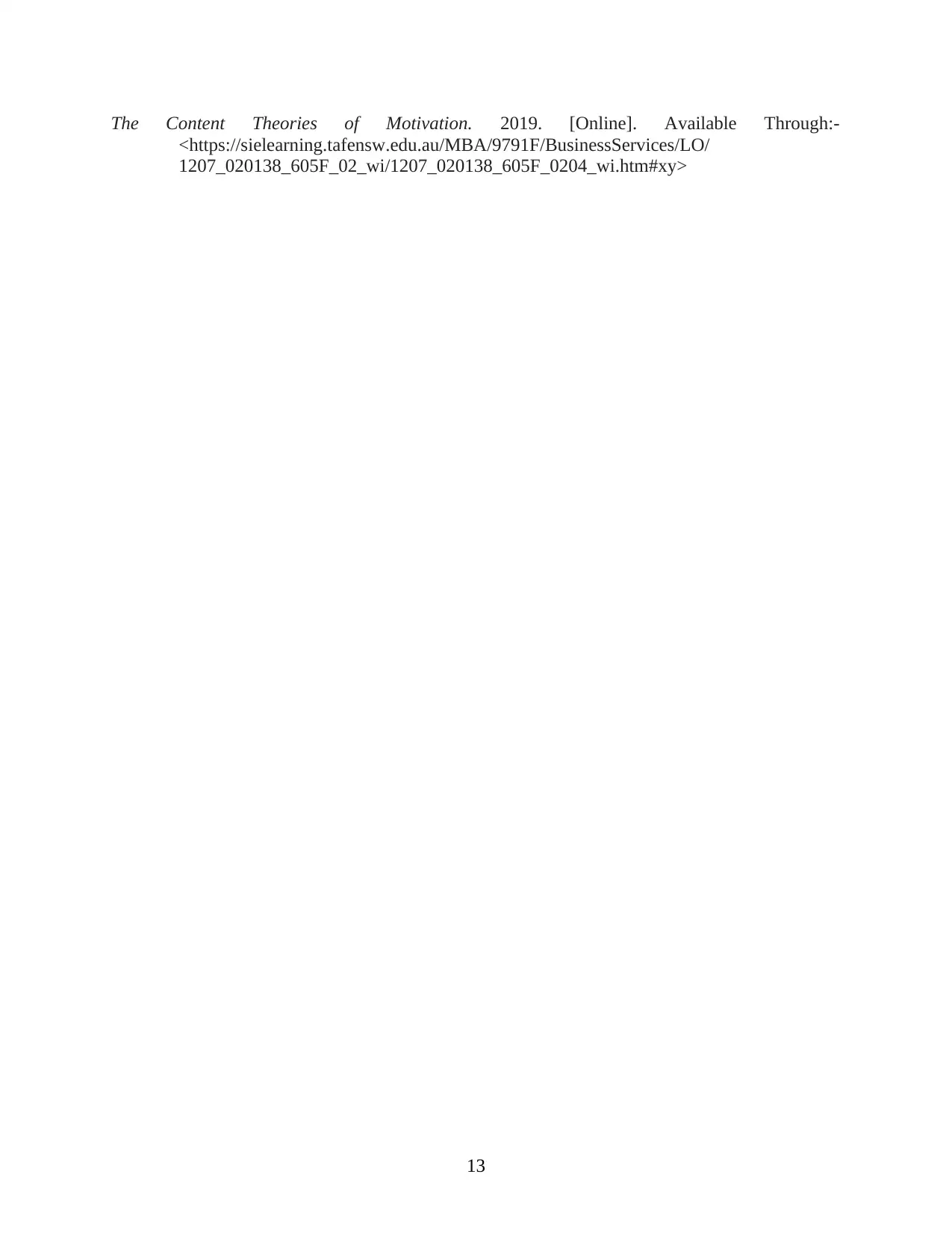
The Content Theories of Motivation. 2019. [Online]. Available Through:-
<https://sielearning.tafensw.edu.au/MBA/9791F/BusinessServices/LO/
1207_020138_605F_02_wi/1207_020138_605F_0204_wi.htm#xy>
13
<https://sielearning.tafensw.edu.au/MBA/9791F/BusinessServices/LO/
1207_020138_605F_02_wi/1207_020138_605F_0204_wi.htm#xy>
13
1 out of 15
Related Documents
Your All-in-One AI-Powered Toolkit for Academic Success.
+13062052269
info@desklib.com
Available 24*7 on WhatsApp / Email
![[object Object]](/_next/static/media/star-bottom.7253800d.svg)
Unlock your academic potential
© 2024 | Zucol Services PVT LTD | All rights reserved.




